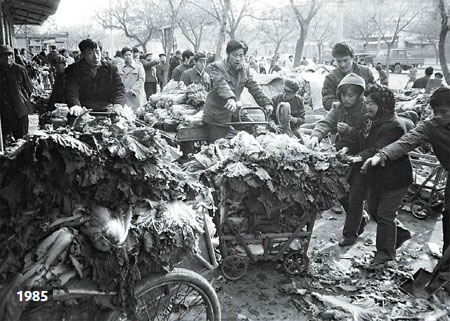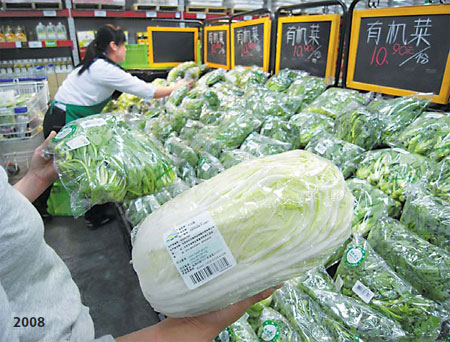
|
BIZCHINA> Wen's Lens
 |
|
Related
Fighting the cabbage wars
By You Nuo (China Daily)
Updated: 2008-12-01 10:52
   Today's urban consumers may be so used to choosing their favorite items from the supermarket shelves (as in this color photo shot in a Beijing Wal-Mart outlet) that they've forgotten how their parents used to buy vegetables. Up to this day, shopping for groceries is still called "buying vegetables," or "mai cai" in Chinese, a phrase which originally has a much narrower definition. It may partly be because unlike meat, vegetables used to be the staple in all household meals. But it may also be because, despite the large variety of vegetables on the Chinese menu, many of them used to be hard to come by. In fact, some 20 years ago, for the entire population of northern China, all the way from small towns in the western Gobi desert to major cities as Beijing and Harbin, housewives had only one green vegetable to rely on for the whole winter. It was the light green Chinese cabbage, or "bai cai" in Chinese. Of course, there were other items such as potatoes and onions. They were also cheap and could be stored in large quantities. But they were not green. Nor were they as versatile as the cabbage, serving as dumpling stuffing as well as being stir-fried. Between November and December was the time for every household to store their winter cabbage supplies. Residents used to be informed by their nearby State-owned grocery shop, by written notice and by word of the mouth, about the arrival of the cabbage shipment. On delivery day, truckloads of cabbages were piled up along the street. All families rushed to the street-side ad-hoc distribution centers, pulling whatever transport tools they could get, from tricycles to old style bamboo baby carriages. For a few days, it was if every city had fallen into a people's war of cabbage. The practice went on year in, year out. Even though many northern Chinese kids were so bored by continuous cabbage dishes in the winter, parents would still place their new orders as every winter approached. They also knew that the price would be kept very low (usually below 0.1 yuan per kilogram), thanks to the government subsidy. Yet that was the limit of the planned economy - a general equality based on a low living standard of only several low-priced major supplies. What is shown in our 1985 black-and-white photo is actually a much milder cabbage war, with far fewer people than in the early 1980s. In fact, between the mid-1980s and 1990s, households in northern Chinese cities bid farewell to the age-old practice of storing cabbages on stairways, balconies and outside windowsills. The growing market economy is now able to provide even the cities in the coldest and most arid areas with vegetables of all kinds. At the same time, not surprisingly, the 0.1-yuan-per-kilo cabbages and the street-side piles disappeared, replaced by carefully wrapped ones on supermarket shelves. Now the challenge facing the government is no longer how to feed 1.3 billion people, but how to ensure the quality of the food they get. (For more biz stories, please visit Industries)
|
主站蜘蛛池模板: 阿克陶县| 蕲春县| 会昌县| 赤壁市| 三门县| 富源县| 齐齐哈尔市| 南丹县| 绿春县| 任丘市| 安仁县| 和平县| 土默特左旗| 巨野县| 耒阳市| 泸溪县| 栾川县| 石城县| 进贤县| 渑池县| 辽阳县| 嘉善县| 永嘉县| 鄂尔多斯市| 印江| 密山市| 新巴尔虎左旗| 乌鲁木齐市| 中西区| 东安县| 本溪市| 正定县| 涞水县| 晋城| 壤塘县| 五华县| 淳安县| 抚顺县| 宣化县| 中山市| 平乡县|